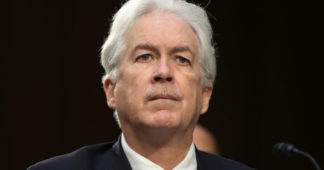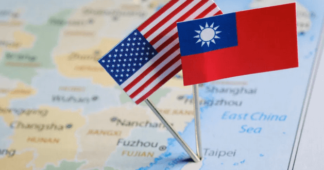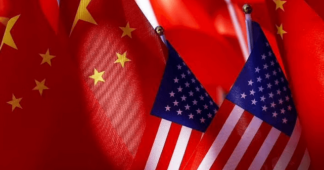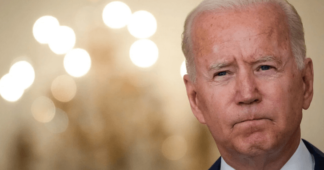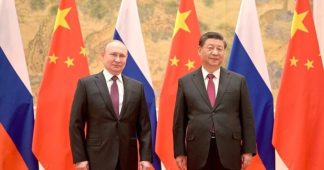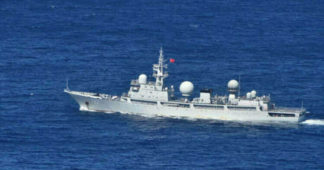By (Clark) Aoqi Wu,
September 8, 2022
Russia’s top leader visits Beijing, meets with his Chinese counterpart, issues a joint communiqué condemning the expansionist policies and aggressive nature of the United States and the West, and declares that the two countries have held “comprehensive discussions and achieved full agreement on major international political issues.” And 20 days after the Russian leader leaves Beijing, a war breaks out. As the conflict intensifies, it threatens to escalate into nuclear warfare (Halperin 2021). Policy makers in Washington suspect that the invasion has been planned by the top leaders of both countries in mutual support of each other (Memorandum 1958a; Memorandum 1958b; Smith 1958).
Surely this scenario refers to the Russian invasion of Ukraine in 2022?
No, these events occurred in 1958, during what historians refer to as the Taiwan Straits Crisis—an incident initiated by Beijing. (See figure at top of page.)
The parallels with 2022 are eerie. Putin left Beijing on February 4 and launched the invasion 20 days later on the 24th; Khrushchev left Beijing on August 3, 1958, and the shelling on Kinmen (then known as Quemoy)—an offshore island controlled by Taiwan—also started 20 days later, on the 23rd of August.
That said, some things have changed noticeably: Back in 1958, the senior partner in China-Russia relations was the Soviet Union/Russia, and it was a much weaker China that launched the attack. Now, the roles have reversed.
The United States’ approach to such conflicts has also changed. During the 1958 crisis, the Eisenhower administration seriously considered using nuclear weapons (Halperin 2021) to deter China from occupying the offshore islands of Kinmen and Matsu (which were claimed by both Western-friendly Taiwan and its notably Western-unfriendly rival—then referred to as “Mainland China” or “Red China”). In contrast, in 2022 the White House has been more cautious about nuclear saber-rattling and is continually attempting to avoid any deeper involvement in the conflict (Sanger, Schmitt, Cooper and Barnes 2022). But despite these changes, the strategic choices the various players have at their disposal remain largely the same. As a result, the 1958 Taiwan Strait Crisis could shed light on the current and future course of China-Russia relations, and Beijing’s attitude to the Russian invasion of Ukraine.
An ambitious Mao and his policy of brinkmanship
The 1958 crisis was created by Mao Zedong—officially the Chairman of the Chinese Communist Party but effectively China’s dictator—in a state of euphoria and confidence, based upon Mao’s belief that what he called a “correlation of forces” had fundamentally changed the global distribution of power. In Mao’s words, “The east wind in the world now prevailed over the west wind” (in today’s parlance, power had shifted from the West to the East) (Mao 1957). In Mao’s assessment, the overall power of the Socialist camp—led by the Soviet Union and China—had reached a turning point and was about to surpass that of the imperialist forces, otherwise known as the United States and the West. With this perception firmly in place, Mao launched a radical “Great Leap Forward” within China around the same time, in an effort to transform a largely agricultural, tradition-minded society into a Communist paradise via rapid, forced collectivization and industrialization by the state; Mao envisaged China overtaking the United States within seven years through this intense mobilization (Mao 1958). Less explicitly, Mao also signaled his belief that China would eventually replace the Soviet Union as the leader of the Socialist camp. (See figure 2.)
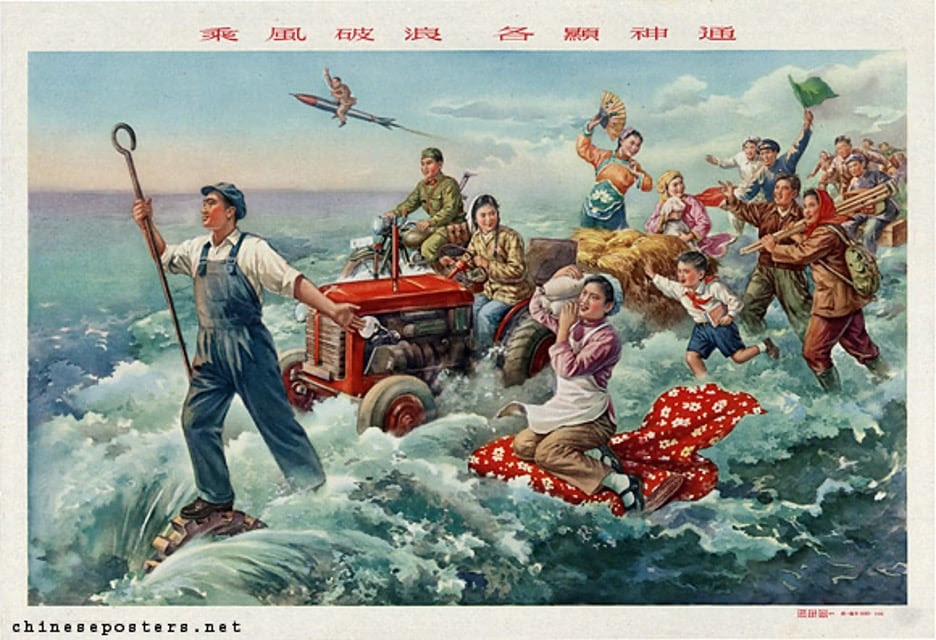 Figure 2: “Brave the wind and the waves, everyone has remarkable abilities,”original 1958 poster. (Note the man in the background riding a rocket while reading a book—possibly a precursor to the “Quotations from Chairman Mao Tse-tung,” better known as “Mao’s Little Red Book.”) Source: https://chineseposters.net/
Figure 2: “Brave the wind and the waves, everyone has remarkable abilities,”original 1958 poster. (Note the man in the background riding a rocket while reading a book—possibly a precursor to the “Quotations from Chairman Mao Tse-tung,” better known as “Mao’s Little Red Book.”) Source: https://chineseposters.net/
Mao’s risky foreign policy regarding these small islands in the straits of Taiwan was also an extension of his radical domestic policy: creating international tensions abroad would strengthen his “revolutionary mobilization” at home (Chen 2001)—proving once again the famous maxim of renowned military theorist Carl von Clausewitz that war is “the continuation of policy by other means.”
Consequently, from early 1958, Mao and his generals began to plan for another attack on the islands of Kinmen and Matsu. In Mao’s assessment, his greatest obstacles to taking over Taiwan were not only the United States (the leading imperialist in the eyes of the Chinese Communists), but also the Soviet Union, a close “big brother”—as it was often referred to at the time in party literature.
This was because Mao’s assessment of the international situation was fundamentally different from Khrushchev’s, especially with regard to American power and the consequences of a nuclear war. Meeting with Communist leaders in Moscow in November 1957, Mao asserted that nuclear weapons were just “paper tigers,” and that World War III would result in the loss of “just” half the global population, which meant that the Communists would win given their population advantage. Khrushchev, by contrast, believed that there would be no winners in a nuclear war (Zubok and Pleshakov 1996; Zubok 2009). He didn’t think as lightly of US military power as Mao did, but Khrushchev did believe that Soviet nuclear weapons were sufficient to deter the United States. Based on this assessment, Khrushchev aimed to coexist with the United States in a nonviolent competition to avoid escalation into a nuclear war.
These different opinions illustrated the diverging grand strategies of the Chinese and the Soviets that already started years before: First, due to their different assessments of US power, Mao pushed for offense—in particular, a policy of brinkmanship to force US concessions—while Khrushchev favored easing tensions with the West. In Mao’s calculation, creating tensions in the Taiwan Strait would undermine Khrushchev’s attempts at so-called “peaceful coexistence” with the United States and force the Soviets to return to what he considered the “correct” revolutionary course.
Mao also insisted on strategic autonomy for China’s actions, while Khrushchev believed that Sino-Soviet relations needed to be further institutionalized and better coordinated/ Khrushchev understood that for general nuclear deterrence to work, the USSR had to prevent its junior allies from dragging it into an unwanted war.
This fear of entrapment was sharply highlighted at the 1957 Moscow conference, where Mao declared that Beijing did not fear a nuclear war with the United States. To prevent Mao from turning into a loose cannon, Khrushchev sought to use the Sino-Soviet alliance to tie China’s hands through various means—such as proposing to build Soviet-operated long-wave radio stations on the coasts of southern China, or asking Mao to allow Soviet submarine forces to use Chinese military bases (Mao 1958; “First Conversation,” July 31, 1958). Mao was furious at such proposals, seeing them—correctly—as a transparent Soviet attempt to control China. He was so upset that Khrushchev felt the need to personally appease an angry Mao, which led to Khrushchev’s trip to Beijing from July 31 to August 3.
During the First Taiwan Strait Crisis (1954-1955), the United States and Taiwan signed a mutual defense treaty, but it only committed the United States to defend the islands of Taiwan and the nearby Pescadores, leaving the far-away islands of Kinmen and Matsu—technically, a pair of archipelagos of very small islands, located more than 100 miles to the west of the island of Taiwan and as little as 5.5 miles off the coast of the Chinese mainland—in a fuzzy pending state (Mutual Defense Treaty 1954). With this in mind, Mao’s military plan was to capture Kinmen and Matsu first, test the US reaction, and then seek an opportunity to advance to the much larger and richer prize of the island of Taiwan.
Such a chance arrived in 1958, when the country of Lebanon fell into a deadly political crisis between Maronite Christians and Arab Muslims, and the Eisenhower administration sent troops to intervene in July. Mao believed that the time had come: This crisis in the Middle East distracted US policymakers and military resources, reducing the possibility of direct US military intervention in East Asia (Niu 2019). Mao also saw this an opportunity to reinforce his position as a world revolutionary leader against US imperialism by showing solidarity to the Arab people and disrupting US intervention in the Middle East (Wu 2014; Pang and Jin 2011).
Mao made up his mind—to attack Kinmen.
Mao used Khrushchev
The ideal scenario for Mao was to force Chiang Kai-shek to abandon these offshore islands simply by shelling and avoiding a bloody landing operation. Keeping in mind the possibility of the United States using its tactical nuclear weapons to prevent the invasion, Mao eyed the Soviet nuclear umbrella as a deterrent.
Mao therefore decided to take advantage of Khrushchev’s visit. Neither Chinese nor Soviet archives recorded any mention by Mao of the intense military planning underway in China in his conversations with Khrushchev.
Khrushchev had intended the trip to be secret, but before he left, Mao asked to make the trip and talks public (Wu 2014, p.111; “First Conversation,” July 31, 1958). At Mao’s request, the two sides also issued a joint communiqué announcing the unanimity of the Soviet and Chinese views on the international situation (People’s Daily 1958). By doing so, Mao sought to create the false impression that China’s imminent attack had been decided in agreement with the top Soviet leaders.
And so did policymakers in Washington believe. Seeing that the Chinese Communist attack had been agreed between Beijing and Moscow, and that the Soviets would be extending their nuclear umbrella to China, Washington took the events happening in the Taiwan Straits as a test of American resolve (Memorandum 1958a; Memorandum 1958b; Smith 1958).
For its part, the Soviet Union had to publicly voice support for the Chinese Communist Party and offer nuclear protection, for the sake of maintaining its prestige as the leader of the Communist movement and to present a united front to the West (Letter 1958). But even while doing so, the Soviet leaders were still trying to figure out what Mao’s real intentions were. Khrushchev also told Mao directly in the subsequent meeting that the Soviets would not fight for Taiwan (Discussion 1959; Khrushchev 2000). This was the end of the Second Taiwan Straits Crisis, and the beginning of the end of the Sino-Soviet alliance.
Lessons for today
So what can this crisis of more than six decades ago tell us about China-Russia relations today? As Stephen Walt—professor of international relations at the Harvard Kennedy School—argues, the behavior of states while in an alliance is determined by their perceived threats from other states, and the degree of threat depends on how they assess the strength and intentions of their adversaries (Walt 1990). That line of inquiry leads us to try to understand how Russian-China relations might evolve by looking at Vladimir Putin’s and Xi Jinping’s assessments of US power and intentions, the level of Western solidarity, and what they perceive as trends in the global distribution of power.
First, it was unlikely that Putin treated Xi the way Mao did Khrushchev. Mao concealed his war plans from Khrushchev due to their vastly different assessments of US capabilities and intentions. Mao did not want Khrushchev to oppose his policy of brinkmanship; rather, Mao sought to manipulate the Soviet Union into an offensive policy stance by taking the first move in Kinmen.
In contrast, Putin and Xi share a very similar view of the United States as an enemy: by their collective lights, the United States is a declining hegemonic power with waning credibility among its allies, leaving China and Russia in a position to regain dominance in their respective regions and expel American influence (Statement 2022; Phone Conversation 2022). They also both accept that it will require a high degree of coordination between them to wear the United States down in Europe and Asia, as they are under no illusion that despite the decline, US military power and economic clout are still formidable.
Therefore, neither Putin nor Xi wants to get into a direct military conflict with the United States at the present time. Moreover, they both believe that whoever occupies the White House (whether Democrat or Republican) will continue to rely on the American-led alliance to contain China and Russia and attempt regime change. Both dictators, whose judgment of America’s intentions are based on similar historical and civilizational concepts, believe their respective countries are exceptional nations with unique and superior cultures, while the “decadent” materialist America is doing everything possible to prevent the return of China and Russia to the status of greatness.
As for China-Russia relations, they have learned lessons from the Sino-Soviet split and are not keen on establishing a formal military alliance, as it would be very difficult to manage given the power asymmetry between them. Just as Mao refused to be further integrated militarily and economically into the Soviet bloc back then, Putin today is equally jealously guarding his strategic autonomy.
Consequently, a more likely scenario for Putin’s February 4 visit was that, out of respect for China as the key strategic partner, he shared part of his military plans with Xi—perhaps without giving Xi a definite answer as to whether he would decide to actually go ahead with these plans down the road. It is also possible that Putin told Xi that he was inclined to use force and assured him that Russia would be able to force major concessions from Ukraine and the West in a short time.
As for Xi, he certainly could not think that he might be able to veto Putin’s war decisions; all he could do was ask Putin that if he did indeed make such a move, to please schedule it after the Beijing Olympics—and inform China of his decision in the meantime (Wong and Barnes 2022).
Second, unless the war escalates into a direct exchange of fire between NATO and Russia, it is unlikely that Xi would even try to pressure Russia into backing down. It is abundantly clear that China is not “neutral” in this war (Buckley 2022). Calculations in Beijing are that the war has diverted US resources to Europe and is forcing the Biden administration to reduce its pressure on China (Myers and Buckley 2022).
At the same time, an outright Russian defeat and the fall of Putin would be the last thing Xi wants to see, because that would mean that China would be facing US containment alone. Hence, despite the loss of international reputation and the economic pressure from the United States, China would be unlikely join the US-led sanctions.
In sum, the 1958 Taiwan Strait Crisis shows us that even manipulative actions from Mao did not prevent Khrushchev from trying to maintain an image of a solid Sino-Soviet alliance in the face of American threats (Letter 1958). Similarly, faced with a united West, Xi will also try to present the façade of a united China-Russia alignment. If Russia continues to struggle in making advances in Ukraine, we may even see China try to pull together developing countries affected by the economic fallout of sanctions to put pressure on the United States (Rolland 2022). We should keep in mind that whenever an opportunity to weaken US leadership shows up, Xi will not let it go to waste.
Acknowledgments
The author gives special thanks to Eliza Gheorghe, the Clements Center Summer Seminar in History and Statecraft, and the Summer Workshop on the Analysis of Military Operations and Strategy (Sponsored by Columbia University’s Saltzman Institute of War and Peace Studies).
We remind our readers that publication of articles on our site does not mean that we agree with what is written. Our policy is to publish anything which we consider of interest, so as to assist our readers in forming their opinions. Sometimes we even publish articles with which we totally disagree, since we believe it is important for our readers to be informed on as wide a spectrum of views as possible.
